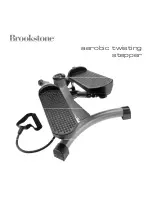
THREAD TENSION
Having selected the correct needle and thread combination for the fabric being used, it
may be necessary to adjust the tension of the sewing machine to ensure a well balanced
stitch.
A well-balanced stitch is produced when the top and under thread appear the same on
the fabric.
Your machine has an adjustable top tension dial. This control exerts tension on the top
and under thread as they pass through the machine to form a stitch.
Too much tension will produce a tight stitch which will cause puckered seams.
Too little tension will produce a loose stitch.
When an even amount of tension is exerted on both threads, a smooth even stitch,
known as a well-balanced stitch, is produced.
Notice the machine tension dial is marked from 1 through 9, and that the settings of 3, 4
and 5 are further distinguished by a small square. The settings of 3, 4 and 5 represent the
general range at which most of your sewing will be done.
HOW DOES TENSION WORK
To help understand the effect of tension on fabric and thread, try this simple test.
Take 2 pieces of a medium weight woven fabric in a solid, light color about 6
” lon
g.
Place a 2020 size 14 needle in the machine.
Thread the top of the machine with an all-purpose thread (darker color) and place the
same type of thread (lighter color) in the bobbin.
Set the machine for Stitch #3, one of the Straight Stitch selections.
Seam the two pieces of fabric together starting with the top tension control at 1. As you
continue to sew, slowly turn the tension dial from 1 through 9.
Sew another row, turning the dial back to 1. You should see a balanced stitch on each
row about midway between the start and finish.
The different colored threads will help you see the effect that tension has on the top and
bottom threads.
Содержание SWM 3000
Страница 80: ...SWM 3000 80...
Страница 132: ...SWM 3000 132 VG SWM 3000 English 2 Deutsch 26 Fran ais 56 Espa ol 82 Italiano 107...
















































